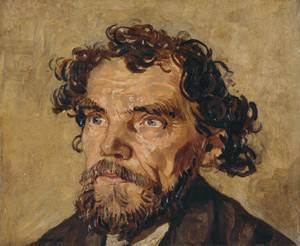
“Head of a man”, previously considered a Van Gogh
A Van Gogh in the National Gallery of Victoria could be a fake NGV Director Gerard Vaughan today announced findings from the Van Gogh Museum’s analysis of the NGV’s painting, Head of a man, traditionally given to Vincent van Gogh]]>
Source: The National Gallery of Victoria
NGV Director Gerard Vaughan today announced findings from the Van Gogh Museum’s analysis of the NGV’s painting, Head of a man, traditionally given to Vincent van Gogh.
The Van Gogh Museum in Amsterdam believes the painting is not by Vincent van Gogh. The Museum concludes that it is not a forgery, but rather is by an as yet unidentified contemporary of Van Gogh.
The Van Gogh Museum based its findings on perceived stylistic differences between the NGV’s painting and other portraits and self-portraits by Van Gogh from around the mid to late 1880s.
The Museum did not find material qualities, either in the canvas or paint which were not contemporaneous with Van Gogh. In other words, there were no “modern pigments” in the work which could only have existed after Van Gogh’s time.
However, the Museum did find that some qualities relating to how the ground layer was applied occurred in no other picture they have analysed, and would thus make this picture unique within Van Gogh’s accepted oeuvre, leading to the conclusion that it is not by Van Gogh. They also concluded that the use of pure ochre as found in the painting is unlike any other works by Van Gogh known at this time, and is therefore anomalous.
The report also bases some of its conclusions on the inability to identify a sitter, the difficulty of establishing provenance before the 1920s, and the fact that there are no concrete references to the painting in Van Gogh’s letters.
NGV Director Dr Gerard Vaughan said that the NGV accepted the Van Gogh Museum’s findings. He acknowledged that the painting had always been regarded as ‘off beat’ and difficult to slot into the accepted chronological development of Van Gogh’s style.
The NGV was fully committed to researching its holdings and to seeking the most expert opinions in relation to attribution. He said that while naturally the NGV was disappointed that the work now appears not to be by Van Gogh, such a reattribution should also be seen as part of the normal work of a public gallery.
“This picture has been in our collection since 1940, when the NGV acquired the work from the French and British Contemporary Art exhibition which toured Australia in 1939 -1940.”
“It was purchased as a Van Gogh work, and had been accepted as a Van Gogh for more than a decade before the NGV’s purchase. It has been included in every catalogue raisonné of the artist’s work by eminent Van Gogh scholars, and has been included without question in major touring exhibitions”, said Dr Vaughan.
“The reattribution of paintings is part of the daily life in any major gallery with a large and complex collection,” said Dr Vaughan. “We regularly change the labels to reflect new research and scholarly opinion.
“In the recent past, we have upgraded the attribution of several key works. Further major news I can announce today is that we have just confirmed with leading international experts the reattribution of a major work: Grand Canal looking north-east to the Rialto Bridge from Studio of Canaletto to Bernardo Bellotto, Canaletto’s nephew and one of the greatest view painters of the 18th century.
Follow us on:
